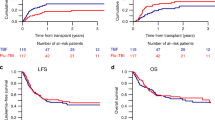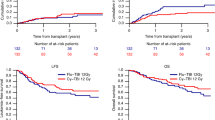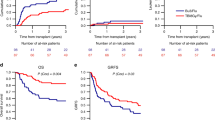Abstract
Biological response modifiers such as interleukin 2 (IL2) may be most effective in the setting of minimal residual disease. In a phase I-II clinical trial, IL2 was administered to 10 patients in remission of acute myeloid leukaemia and three with multiple myeloma 1-4 weeks after treatment with ablative chemotherapy or chemotherapy and autologous bone marrow transplantation. The aim was to assess the capacity of these patients to tolerate IL2 after intensive therapy and to determine whether regenerating lymphocytes were capable of responding to IL2 with the generation of anti-leukaemic effector cells. Toxicity was severe in two patients treated with escalating doses of IL2 and 19 subsequent infusions administered to 11 patients on a fixed dose schedule for periods of 3-5 days were well tolerated. Major toxicity was confined to hypotension (two courses) which responded rapidly to treatment cessation. No patients required intensive care unit support. IL2 infusions produced no significant adverse effects on marrow regeneration; while there were transient falls in platelet counts there were no episodes of clinical bleeding and neutrophil counts increased from a mean of 1.1 pre-infusion to 2.5 x 10(9)l-1 during the infusion (P = 0.004). A significant biochemical abnormality was hypokalaemia which responded rapidly to correction. Cells with activity against leukaemic progenitor cells appeared in peripheral blood within 48 h of beginning treatment. We conclude that IL2 may be used in minimal residual haematological malignancy, and by producing anti-neoplastic effector cells has the potential, as yet unproven, to prolong disease-free survival of patients entering remission.
This is a preview of subscription content, access via your institution
Access options
Subscribe to this journal
Receive 24 print issues and online access
$259.00 per year
only $10.79 per issue
Buy this article
- Purchase on Springer Link
- Instant access to full article PDF
Prices may be subject to local taxes which are calculated during checkout
Similar content being viewed by others
Author information
Authors and Affiliations
Rights and permissions
About this article
Cite this article
Gottlieb, D., Brenner, M., Heslop, H. et al. A phase I clinical trial of recombinant interleukin 2 following high dose chemo-radiotherapy for haematological malignancy: applicability to the elimination of minimal residual disease. Br J Cancer 60, 610–615 (1989). https://doi.org/10.1038/bjc.1989.324
Issue Date:
DOI: https://doi.org/10.1038/bjc.1989.324
This article is cited by
-
Targeting lysophosphatidic acid receptor with Ki16425 impedes T cell lymphoma progression through apoptosis induction, glycolysis inhibition, and activation of antitumor immune response
Apoptosis (2022)
-
IL-2-based immunotherapy after autologous transplantation for lymphoma and breast cancer induces immune activation and cytokine release: a phase I/II trial
Bone Marrow Transplantation (2003)
-
Role of Immunotherapy in Stem Cell Transplantation
International Journal of Hematology (2003)
-
Graft-versus-host disease following interleukin-2/lymphokine-activated killer (LAK) cell immunotherapy in a patient with acute myelogenous leukaemia in second complete remission: autologous LAK cells following allogeneic bone marrow transplantation are donor-derived
Cancer Immunology Immunotherapy (1995)
-
Immunological Therapy of Breast Cancer
Clinical Immunotherapeutics (1994)



